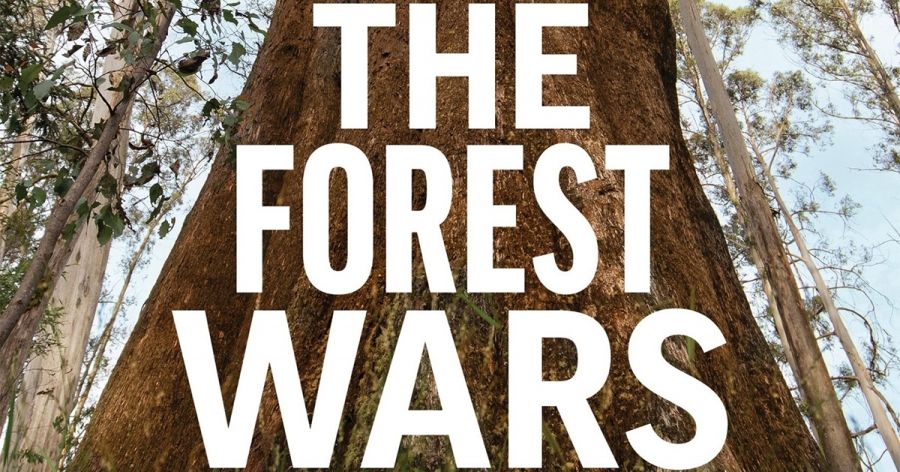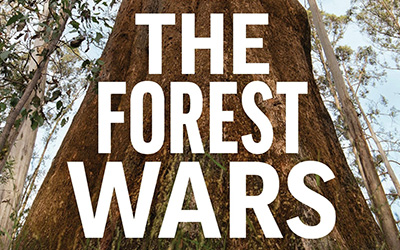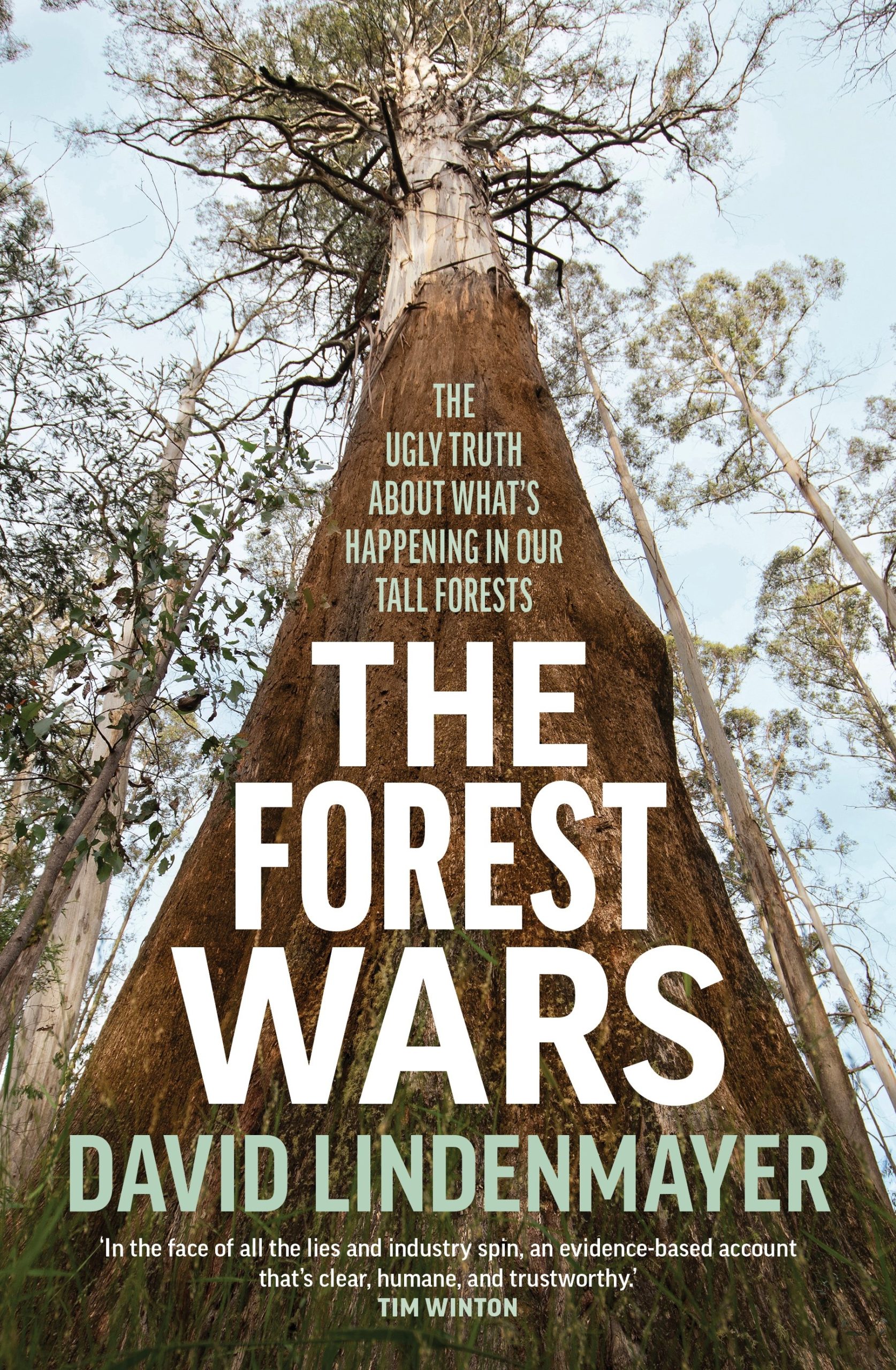
- Free Article: No
- Contents Category: Environment
- Review Article: Yes
- Article Title: The future of forests
- Article Subtitle: A critique of Australian forestry
- Online Only: No
- Custom Highlight Text:
Shortly after Black Saturday, David Lindenmayer was giving a seminar on post-bushfire recovery when a member of the audience yelled out, ‘If it wasn’t for you greenies, none of this would have happened.’ Lindenmayer’s response was neither defence nor attack, but rather to rephrase the man’s words. ‘Your hypothesis,’ he said, ‘is that a fire in a forest that is logged and regenerated will be less severe than a fire in an intact forest.’ Many years of research followed this heckle. The result? A counter-intuitive finding that fire severity increases in logged forests.
- Featured Image (400px * 250px):

- Alt Tag (Featured Image): Dave Witty reviews ‘Forest Wars: The ugly truth about what’s happening in our tall forests’ by David Lindenmayer
- Book 1 Title: Forest Wars
- Book 1 Subtitle: The ugly truth about what's happening in our tall forests
- Book 1 Biblio: Allen & Unwin, $34.99 pb, 288 pp
- Book 1 Cover Small (400 x 600):

- Book 1 Cover (800 x 1200):

Perhaps ‘The Future Forest’ would be a more appropriate title for this book. ‘Forest wars’ calls to mind the environmental blockades and guerrilla warfare so famously described in Anna Krien’s Into the Woods (2012). With the war superficially over (the forestry industry vanquished, and the environmentalists celebrating only the most pyrrhic of victories), it is this sense of postwar uncertainty and the clouded future of forest management that pervades Lindenmayer’s book.
The Great Forest, Lindenmayer’s previous book, was a pleasant surprise: a coffee-table book celebrating the forests of the Central Highlands. Previously, he had mainly published textbooks on topics such as natural asset farming or ecological monitoring. The style of his latest book is noticeably different. One by one, thirty-seven myths about forestry are laid out and refuted. The tone is personal, the prose more stylised. As Lindenmayer acknowledges, he has been ‘trained as a scientist to write in a dense and formulaic way’. This is his attempt at a layperson’s book, one that is ‘a little less boring than it might otherwise have been’.
For the most part, Lindenmayer succeeds. A wealth of information is conveyed in fewer than 300 pages, the science elevated by anecdote and personal reflection. The only downside to this structure is repetition: the same facts and conclusions are used in the refutation of different myths.
At times, Lindenmayer dispenses with nuance, such as when he accuses VicForests of bastardry and environmental sabotage for deliberately logging areas already reserved for national parks (an accusation it strongly denies). But it would be wrong to label Lindenmayer the obstructionist that some critics accuse him of being. For many years, he worked alongside VicForests in pursuit of more sustainable logging practices. It is only recently that he has adopted a more hardline stance. As he says in the Wonderground interview: ‘Why would you keep pushing a loss-making industry that employs just a few hundred people whilst screwing over the water supply, boosting carbon emissions, and making places more fire prone?’
The day I finished The Forest Wars, I read an article in which the Dja Dja Wurrung Clans Aboriginal Corporation (DJAARA) accused Lindenmayer of ‘speaking down’ to traditional owners. The article relates to Myth Eleven in which Lindenmayer suggests forest gardening, a practice where forests are thinned to bring them closer in appearance to the pre-European landscape, is an attempt by VicForests to ‘rebadge its logging operations under the banner of Traditional Owner forest management’. The DJAARA’s call for The Forest Wars to be withdrawn from sale feels like an overreaction, but Lindenmayer’s assessment of forest gardening does highlight two criticisms that may reasonably be levelled at Lindenmayer.
First, forest gardening is as much about regenerating the landscape through soil improvement and selective plantings as it is about simply removing a few trees. By focusing so much energy on debunking one particular element, Lindenmayer is, to paraphrase the saying, letting a few trees cloud his vision of the wood. Second, his concern that thinned forests are more fire prone than intact ones. There is empirical research to back this finding and he recounts these studies in Myth Thirteen, but the research he cites is that of his colleagues. Where are the countervailing studies and his responses to their claims?
Writer Georgina Reid has described Lindenmayer as a forest of a man. A more fitting symbol might be the tree on the book’s front cover. A mountain ash. Strong. Resolute. Indefatigable. In a country that lops tall poppies, what could be more enticing than cutting down the tallest flowering tree in the world?
While this book will inevitably attract controversy, it is, at its heart, a paean to the forest. Lindenmayer, despite his critique, is a self-described ‘person of hope’. ‘I am confident,’ he writes at the start of Chapter Twelve, reflecting on how humpback whale populations recovered from near extinction, that ‘our native forests will also recover if we stop logging them and manage them well’. It is a compelling message, and it comes at a critical time.


Comments powered by CComment